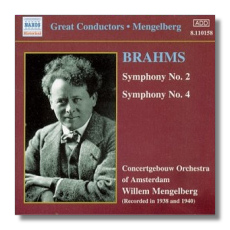
The Internet's Premier Classical Music Source
Related Links
- Brahms Reviews
- Latest Reviews
- More Reviews
-
By Composer
-
Collections
DVD & Blu-ray
Books
Concert Reviews
Articles/Interviews
Software
Audio
Search Amazon
Recommended Links
Site News
 CD Review
CD Review
Johannes Brahms

- Symphony #2 in D Major, Op. 73
- Symphony #4 in E minor, Op. 98
Amsterdam Concertgebouw Orchestra/Willem Mengelberg
Naxos 8.110158
As Ward Marston's notes on the production of this disc tell us, these recordings were a result of Telefunken embarking on a recording series with Mengelberg and the Concertgebouw in 1937. The 2nd Symphony is from 1940 and the fourth from 1938. An interesting note from Ward points out that there is much more hall ambience in the 2nd Symphony due to the closer placement of mikes when the 4th was recorded.
For this review I decided to pull out Stokowski's 1929 and 1933 recordings with the Philadelphia Orchestra (Biddulph 17-18). I am writing this before having done any direct comparisons so far. I am interested in how the recordings will sound given the different dates and recording companies. In addition, Ward Marston remastered both recordings and I wonder what differences there will be. I am also going to be listening for the differences in the sound of the two conductors. So it goes.
Okay, this wasn't even close in the case of the Second Symphony. Stokowski's orchestra sounds like there are double basses clear across the back of the orchestra. They provide orchestral backdrop from which we can hear the other music emerge not unlike patterns in an oriental rug. The Stokowski Sound is apparent immediately. I like it. That, coupled with slower tempi, lends matters a more autumnal glow and flow to the music. Now, some people may find the sound a bit "tubby" but it is the overall effect that is important. I do not mean to imply that the Mengelberg is not good, on the contrary.
His recording of the 2nd Symphony is leaner than Stokowski's. There is less reverberation and an inner depth that is not in the Philadelphia recording. This may be due to improvements in the recording process over 13 years. It is "athletic" as the notes put it. It is faster than Stokowski and offers an excellent alternative. What strikes me most is that it has EMOTION. It has FEELING. I recall a comment by the 95 year-old Stokowski. "Emotion, life… or lifeless."
On to the 4th Symphony. This is a whole different kettle of fish. For one thing, the remastering is cut at a higher level. Again, it is a leaner sound; there is more of a depth perspective than in the Philadelphia recording. This may be due to Ward making sure that The Stokowski Sound had that bass line that he was famous for and accentuating it in lieu of depth. Then, again, the forces used in the Stokowski recording were smaller, and like the Concertgebouw recording, had closer microphone placement. The Stokowski recording is a bit tubby here but it is an exciting performance. I can imagine the audience, if there had been one, leaping to their feet at the conclusion. The Mengelberg is no less exciting. He did not have a "sound" like Stokowski or Toscanini, on the other hand, "He belonged to the Wagnerian school as a stylist. A true romantic, he would slow down between contrasting passages, use rubato and leave little to the imagination." (Harold Schonberg, The Great Conductors 1967. Which do I prefer? Both will do very nicely, thank you very much.
I mentioned the higher level of transfer in the Naxos recording. Another Marston difference is that the Naxos disc has less surface noise. This may be due to a number of factors. It does make the Mengelberg recording "cleaner" sounding.
So, once again I am urging the reader to get both recordings. To really understand a piece of music you must hear different performances/recordings. To really appreciate how different the "Golden Age" conductors were is another reason for duplication. * The Biddulph may be difficult to find. I'd keep my eye on Berkshire Record Outlet for copies.
Post Script: Mengelberg was a truly great conductor. When he was younger he led the music of Mahler. Strauss dedicated Ein Heldenleban to his Concertgebouw orchestra. After the Nazi occupation, however, he accepted a post in their "Culture Cabinet" and many Jewish musicians were removed from the orchestra. Unlike Furtwängler, he was shunned and lived the rest of his life self exiled in Switzerland.
*The notes by Ian Julier are a bit maddening. About Mengelberg's style he writes, "Nor does he subject the music to the extremes of subjective hyperbole that we readily associate with Leopold Stokowski, perhaps the conductor with whom Mengelberg's questing brand of recreative spirit is most closely aligned." To be honest, I am not sure what the hell that is supposed to mean.
Copyright © 2002, Robert Stumpf II


















